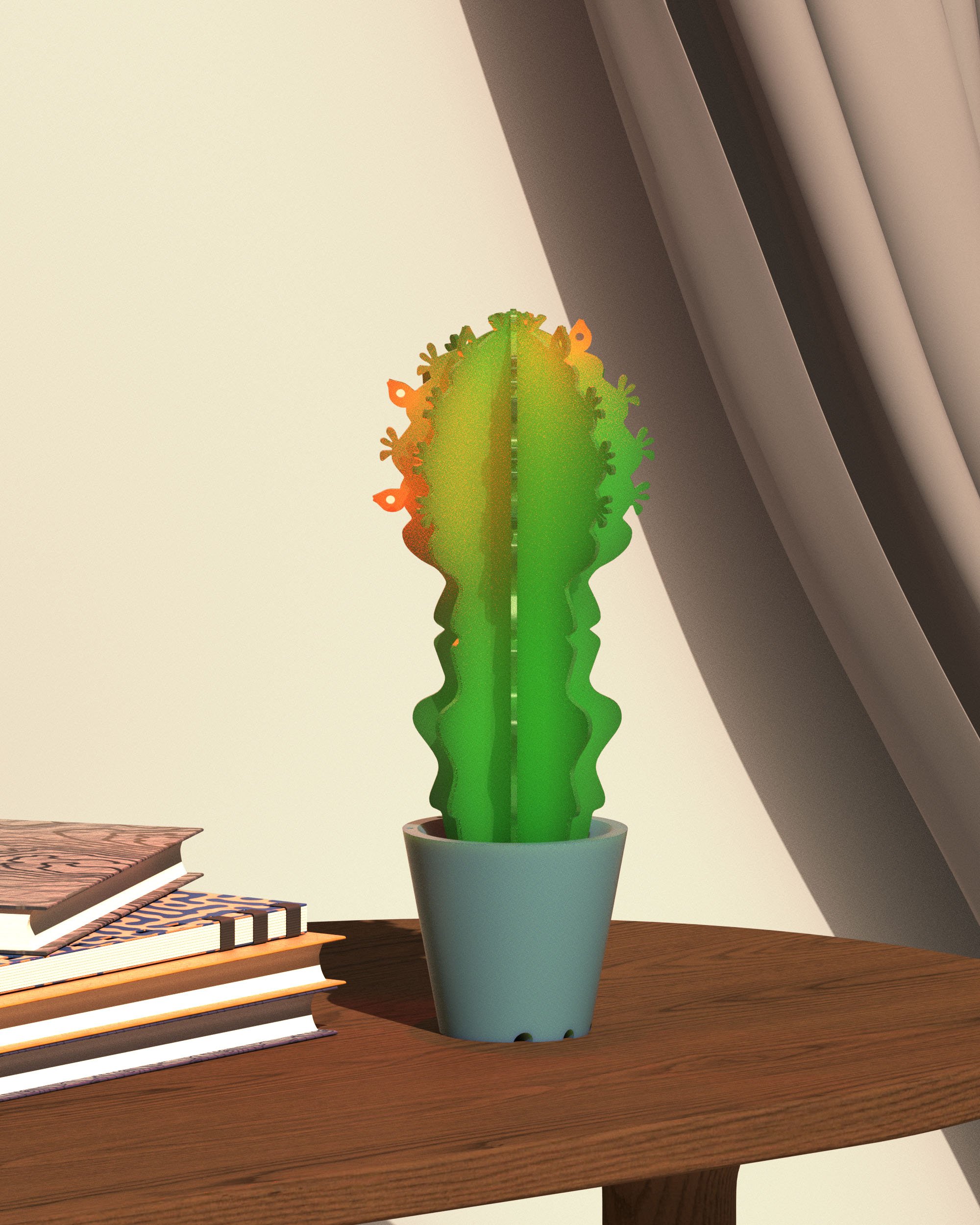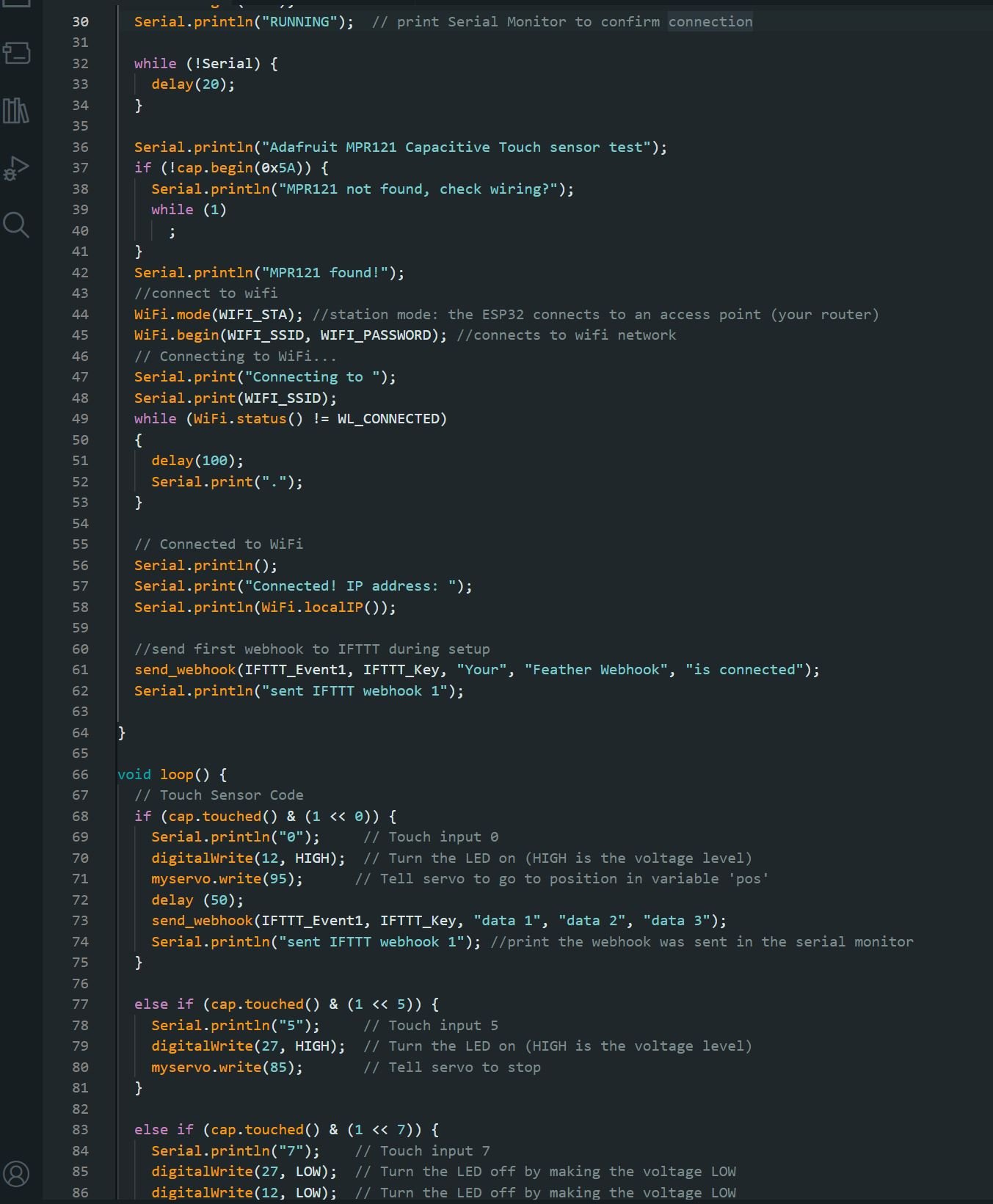
Where technology meets hydration, Turning Sips into Smiles with every touch
HYDRACACTUS
University of Pennsylvania [Fall 2023]
Taylor Caputo, IPD529 Critic
-
Arduino, C++, Adafruit ESP32 Feather V2, IFTTT, Rhinoceros 3D, V-Ray for Rhino, Photoshop
3D Printing, Soldering
-
Product Design, Hardware Prototyping, Coding, Digital Visualization, Model Making
Hydracactus Digital Pet, powered by the Adafruit Feather ESP32 V2, merges technology and hydration in a playful design. The central microcontroller connects to Wi-Fi, interprets touch inputs via the MPR121 capacitive touch sensor, and controls a continuous rotation servo. Illuminating LEDs and displaying a 'stay hydrated' message, the capacitive touch sensors on pins 0, 5, and 7 trigger specific responses. Capacitive touch 0 sends a Gmail reminder and servo rotation, touch 5 halts the servo, and touch 7 deactivates LEDs and stops the servo. With the IFTTT service, an applet named 'drink_more_water' sends a personalized email reminder when capacitive touch 0 is activated, fostering a user-friendly and interactive approach to healthy hydration habits.
INITIAL DESIGN CONCEPT
Option 01 - Oasis Sprout
Touch Sensor: Records water consumption with a single touch, making hydration tracking effortless.
Visual Tracker: Red light bulbs mimic prickly pear fruit, visually tracking water intake in a playful and intuitive way.
Hydration Reminder: Servo-attached watering pot rotates gracefully every 5 minutes, providing a friendly reminder to sip and stay hydrated.
Automated Notification: By noon, triggers an email notification via IFTTT if 4 cups of water have not been consumed
HARDWARE PROTOTYPE
The Adafruit Feather ESP32 V2 serves as the central microcontroller, responsible for connecting to Wi-Fi, handling capacitive touch inputs, controlling a continuous rotation servo, and triggering IFTTT events. The MPR121 capacitive touch sensor, interacting with the Adafruit MPR121 library, illuminates LEDs and controls the continuous rotation servo based on user interactions. The continuous rotation servo, managed by the Servo library, adjusts its position according to the capacitive touch input. The IFTTT integration, specifically the "drink_more_water" applet, sends a personalized email reminder when capacitive touch sensor 0 is activated, completing the feedback loop for hydration tracking.
^ Testing Touch Sensors and Continuous Rotation Servos
^ Snip of Source Code
Option 02 - AquaBloom
Touch Sensor: Records water consumption with three touch points that are integrated into the 3D-Printed blue pot
Visual Tracker: Red light bulbs mimic prickly pear fruit, visually tracking water intake in a playful and intuitive way.
Hydration Reminder: Servo-attached “Hydrate” sign rotates when touch sensors are activated, providing a friendly reminder to stay hydrated.
Automated Notification: When the first touch sensor is activated, it will trigger an email notification via IFTTT to remind user to hydrate
DESIGN
^ List of Hardware Components Used
FINAL DESIGN
01 FEATHER ESP32 V2
Central microcontroller handling Wi-Fi connection, capacitive touch inputs, continuous rotation servo control, and IFTTT event triggering.
02 MPR121 CAPACITIVE TOUCH SENSOR
When capacitive touch sensor 0 is interacted with, it illuminates LED1 on pin 12, indicating that 4 cups of water have been consumed on that day. Simultaneously, the continuous rotation servo on pin 13 rotates the message "stay hydrated" and sends a Gmail reminder Webhook to "drink_more_water."
When capacitive touch sensor 5 is interacted with, it illuminates LED2 on pin 27, indicating that 8 cups of water have been consumed on that day. Simultaneously, the continuous rotation servo on pin 13, displaying "stay hydrated," halts to indicate that the user has met their water intake goal.
When capacitive touch sensor 7 is touched, it deactivates the LEDs connected to pins 12 and 27 and brings the continuous rotation servo on pin 13 to a halt.
03 CONTINUOUS ROTATION SERVO
Controlled by the Servo library, adjusts position according to capacitive touch input, providing visual feedback for hydration tracking.
takeaways
AREAS FOR IMPROVEMENT
Unlock the Potential of Continuous Servo Motors
Recognizing the untapped capabilities of continuous servo motors, there is substantial room for improvement in harnessing their full potential within the project's framework. Given an extended timeline, a key aspiration is to elevate the integration of servos, delving into the realm of more intricate movements. The vision includes incorporating 3D printed mechanical components to transcend the simplicity of a standard 360-degree rotation, introducing dynamic and multifaceted motions.
Streamline Aesthetics and Functionality through Design Optimization
A focal point for refinement revolves around enhancing the design of the 3D printed pot. The goal is to craft a purposeful housing unit capable of seamlessly accommodating all hardware elements. Inspired by the elegant integration of touch sensor wires, extending this streamlined approach to encompass the entirety of wiring and boards promises a comprehensive enhancement in both aesthetics and functionality.







